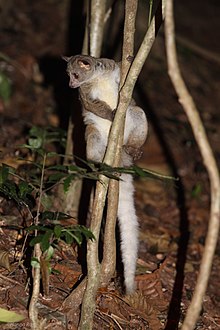geo.wikisort.org - Mountains
The Taita Hills, sometimes also spelled as Teita Hills, are a mountain range located in the Taita-Taveta County in south-eastern Kenya. The hills consist of three massifs: Dawida, Sagalla in the southern side of Voi township and Kasigau in the south near the border of Tanzania. The Dawida massif is the largest and tallest of the three, with an altitude of 2,228 metres (7,310 ft) above sea level at its highest peak, Vuria. Dabida has three other main peaks: Iyale, Wesu, and Susu.[1]



Geology
The Taita Hills, with others in the Eastern Arc Mountains, were formed more than one hundred million years ago. About thirty million years ago, the area was covered by extensive rainforest. During a cooler and drier period some ten million years ago, the lowland forests were converted to savanna, leaving the mountain ranges as "islands" where the tropical forests continued to flourish. The isolation of each mountain range has led to a great deal of endemism, and a very diverse flora and fauna. Some of the other mountain ranges are well-forested, but the Taita Hills retain just 6 km2 (2.3 sq mi) of forest.[2] The Taita Hills rise steeply from the Tsavo West National Park.[1]
Ecology
The hills are known for their moist forests with a unique fauna and flora. More than 20 endemic species of African violets (e.g., Streptocarpus teitensis) occur exclusively in that region. Known endemic bird species are the Taita thrush (Turdus helleri) and the Taita apalis (Apalis fuscigularis). The Taita falcon (Falco fasciinucha) and the Taita fiscal (Lanius dorsalis) were first discovered at the hills but occur elsewhere, too. An amphibian in the genus Boulengerula occurs only in the Taita Hills. The Sagala caecilian (Boulengerula niedeni) is a critically endangered worm-like amphibian that lives in the Taita Hills.[1]
The native Taita people are living at the edge of the forests and farming the soil, which is very productive. Fifty percent of indigenous forests were replaced by exotic tree plantations between 1955 and 2004.[3] The region was severely logged in the past and the remaining indigenous forest is now part of a nature reserve, the Taita Hills Wildlife Sanctuary. On the plains and foothills surrounding the hills, the land is predominantly used for cropping and grazing. The largest fragments of forest are located in the most inaccessible areas. The land is being degraded by deforestation, the lowering of the water table, and soil erosion. The annual rainfall varies from 500 mm (20 in) in the lowlands to more than three times this amount in the mountain zone. This area experiences two rainy seasons: March to May or June, and October to December, but the precipitation is very variable.[4] Remaining forests are amazingly abundant with all forms of life [5] Taita Hills are home to Small-Eared Greater Galago (Otolemur garnettii) and rare, but locally abundant tree hyrax (Dendrohyrax sp.)[6]. Dwarf galago (Paragalago cocos) is still also living in Taita Hills, although it is close to extinction [7]
References
- "Taita Hills Forests". Important Bird and Biodiversity Area factsheet. BirdLife International (2016) : Taita Hills Forests. Retrieved 21 October 2016.
- Briggs, Philip (2009). Northern Tanzania: The Bradt Safari Guide with Kilimanjaro and Zanzibar. Bradt Travel Guides. pp. 20–21. ISBN 978-1-84162-292-7.
- Pellikka P. K., Lotjonen M., Siljander M. & Lens L. 2009: Airborne Remote Sensing of Spatiotemporal Change (1955–2004) in Indigenous and Exotic Forest Cover in the Taita Hills, Kenya International Journal of Applied Earth Observation and Geoinformation 11 (2009) 221–232
- Trillo, Richard (2002). Kenya. Rough Guides. p. 381. ISBN 978-1-85828-859-8.
- Wagura 2014, A Guide to Taita Hills.
- Rosti, H.; Pihlström, H.; Bearder, S.; Pellikka, P.; Rikkinen, J. Vocalization Analyses of Nocturnal Arboreal Mammals of the Taita Hills, Kenya. Diversity 2020, 12, 473. https://doi.org/10.3390/d12120473
- Rosti, H., Rikkinen, J., Pellikka, P., Bearder, S., & Mwamodenyi, J. (2020). Taita Mountain dwarf galago is extant in the Taita Hills of Kenya. Oryx, 54(2), 152-153. doi:10.1017/S003060531900142X
External links
На других языках
[de] Taita Hills
Die kenianischen Taita Hills sind die nördlichsten Ausläufer der ostafrikanischen Eastern Arc Mountains. Diese stellen eine Kette alter Gebirgsmassive dar und sind mit Regen-/Nebelwäldern und Grasland bestanden. Die Eastern Arc Mountains und somit auch die Taita Hills entstanden im Präkambrium. Es wird davon ausgegangen, dass ihre Wälder seit mehr als 30 Millionen Jahren existieren und ursprünglich mit denen im Kongobecken und in Westafrika verbunden waren.[1][2]- [en] Taita Hills
[fr] Monts Taita
Les monts Taita sont un massif montagneux du Kenya, ils sont situés à 50 km à l'est du Kilimandjaro, ils culminent à 2 209 m d'altitude.[it] Monti Taita
I monti Taita (in inglese Taita Hills) sono un gruppo montuoso del Kenya meridionale, situati circa 50 km ad est del Kilimanjaro. Costituiscono l'estremità settentrionale della catena dei Monti dell'Arco Orientale.[ru] Таита (горы)
Таита[2] (Теита[1], англ. Taita Hills, Teita Hills) — горы (холмы[2]) в Кении, в Прибрежной провинции. Представляют собой часть разбросанных изолированных холмов и гор, которые нарушают монотонный характер плоского рельефа большей части района, не отличающегося значительными высотами[2]. Состоят из трёх массивов: Дабига (Dabida), Сагалла (Сагала[1], Sagalla) южнее города Вои и ещё южнее — Касигау[2] (Касигао[1], Kasigau, 1645 м[1] или 1544 м[2]). Массив Дабига самый крупный и высокий, его высота достигает 2211 метров над уровнем моря[1] (2209 м[2]), высочайший пик — Вурия (Vuria). Являются частью Восточного рифта.Другой контент может иметь иную лицензию. Перед использованием материалов сайта WikiSort.org внимательно изучите правила лицензирования конкретных элементов наполнения сайта.
WikiSort.org - проект по пересортировке и дополнению контента Википедии